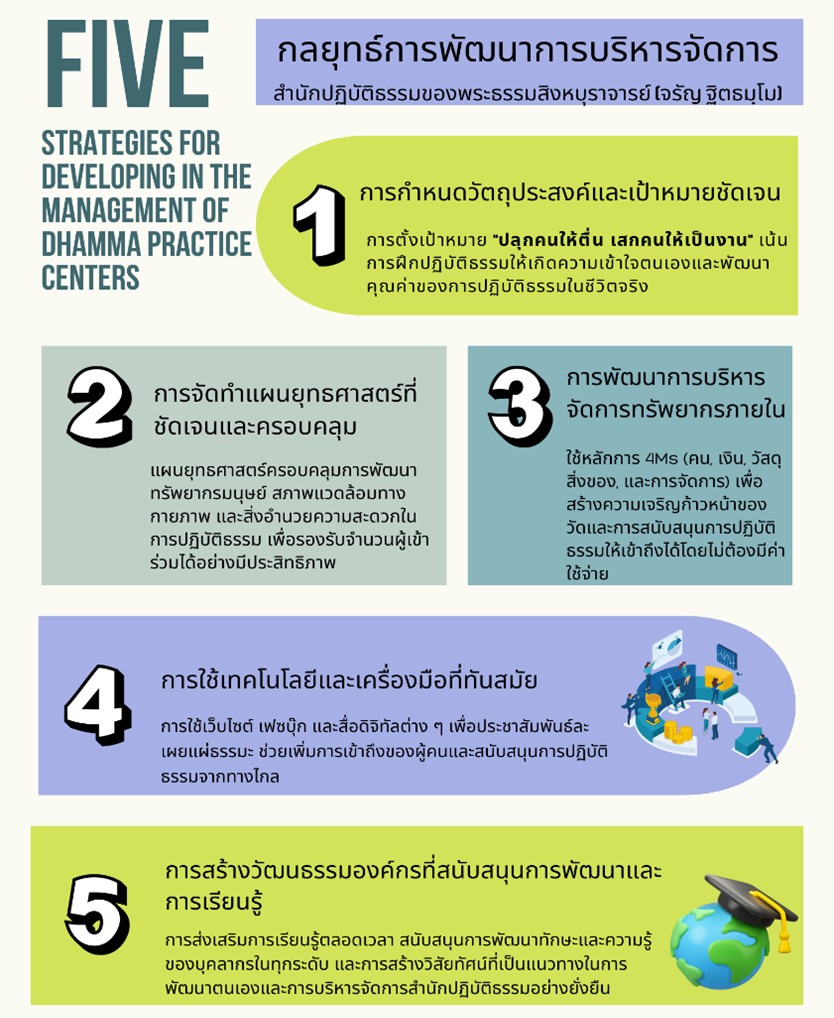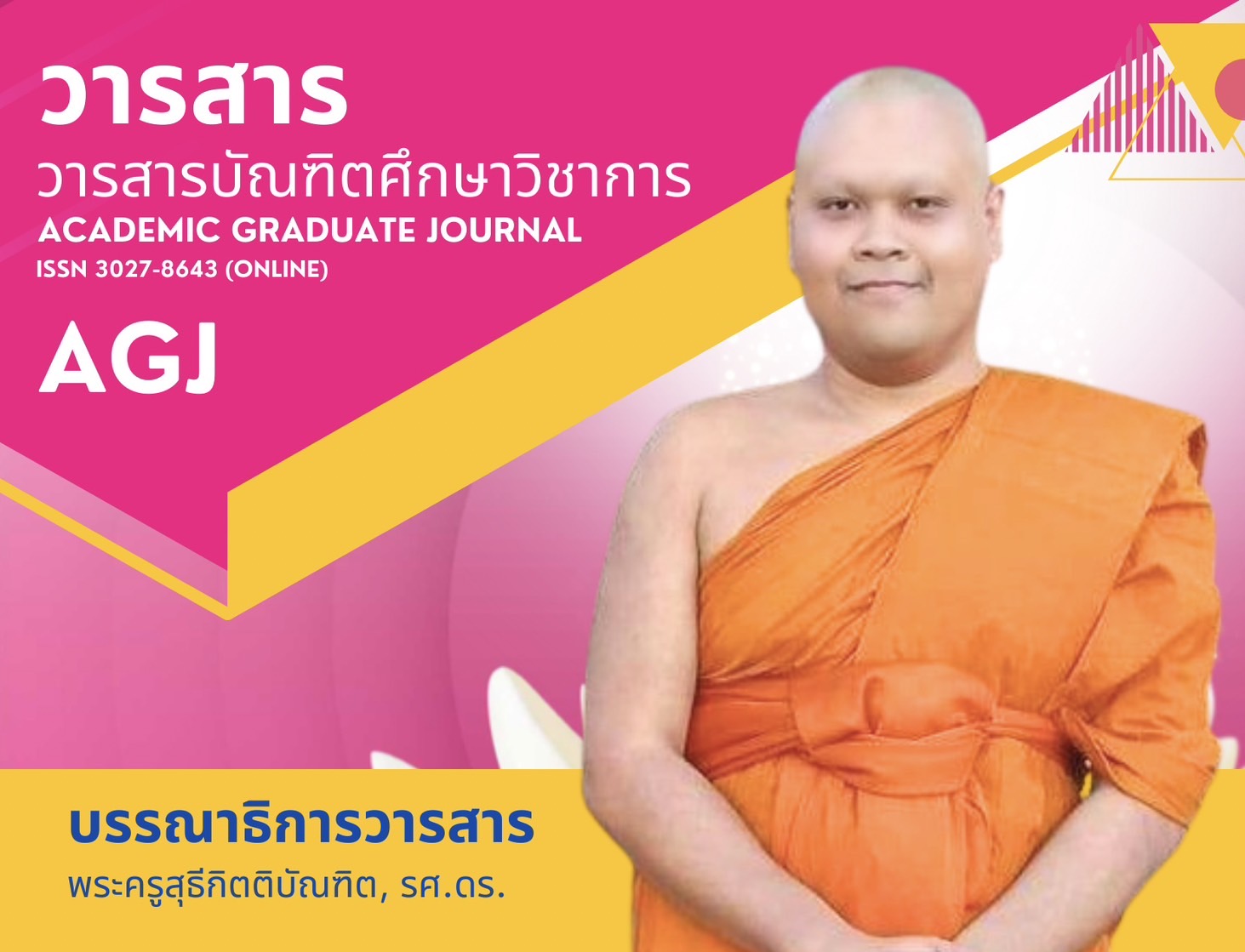STRATEGIES FOR DEVELOPING IN THE MANAGEMENT OF DHAMMA PRACTICE CENTERS OF PHRA DHAMMASINGHABURAJARN (CHARAN THITADHAMMO)
Keywords:
Management, Dhamma Practice Centers, Phra DhammasinghaburajarnAbstract
This article is a study of the development strategy for managing the Dhamma Practice Office of Phra Dhammasinghaburajanacariya (Charan Thitadhammo), the former abbot of Wat Amphawan, former head of the Dhamma Practice Office No. 1 in Singburi Province. The study uses research methods, including document review, research work, and participatory observation. The study found success in formulating the development strategy for managing the Dhamma Practice Office of Phra Dhammasinghaburajanacariya (Charan Thitadhammo), the Supreme Patriarch, the practitioner, and the developer serve as good models. It is dedicated to propagating Buddhism and benefiting the country and its people throughout life. They develop the temple and nurture individuals by training and guiding interested Buddhists of all genders and ages in practising the fundamental principles of Buddhism. The strategy for developing the management of the Dhamma Practice Office has been effective, with clear objectives and goals being set, namely “awakening people, instigating them to act,” because practising Dhamma is training to develop the mind to understand oneself, speak for oneself, use oneself, and create strategies that align with temple development to suit the Dhamma practice of the laypeople. Modern technology and appropriate tools are selected and utilised, along with the creation of an organisational culture that supports development, resulting in the esteemed reputation of Luang Pho being widely recognised both domestically and internationally, attracting continuous interest and engagement in Dhamma practice throughout the year.
References
กัลยารัตน์ ธีระธนชัยกุล. (2558). การพัฒนาองค์การ. กรุงเทพฯ: บริษัท ซีเอ็ดยูเคชั่น จำกัด.
พระธรรมธีรราชมหามุนี (โชดก ญาณสิทฺธิ). (2554). วิปัสสนากรรมฐาน (ครั้งที่ 3). กรุงเทพฯ: บริษัท ประยูรวงศ์พริ้นท์ติ้ง จำกัด.
พระธรรมสิงหบุราจารย์ (จรัญ ฐิตธมฺโม). (2557). กฎแห่งกรรม ธรรมปฏิบัติ เล่ม 28. กรุงเทพฯ: หอรัตนชัย การพิมพ์.
พระธรรมสิงหบุราจารย์ (จรัญ ฐิตธมฺโม). (2544). อนุสาสนีปาฏิหาริย์. กรุงเทพฯ: บริษัท รุ่งเรืองวิริยะพัฒนาโรงพิมพ์ จำกัด.
พระนรินทร์ โชติปาโล (ศรีสวรรค์กุล). (2566). การพัฒนาการบริหารจัดการสำนักปฏิบัติธรรมประจำจังหวัดสิงห์บุรี แห่งที่ 1 วัดอัมพวัน (สารนิพนธ์พุทธศาสตรมหาบัณฑิต สาขาวิชาการจัดการเชิงพุทธ). พระนครศรีอยุธยา: มหาวิทยาลัยมหาจุฬาลงกรณราชวิทยาลัย.
พระพรหมคุณาภรณ์ (ป.อ. ปยุตฺโต). (2556). พจนานุกรมพุทธศาสตร์ ฉบับประมวลธรรม. กรุงเทพฯ: โรงพิมพ์พระพุทธศาสนาของธรรมสภา.
พระราชสุทธิญาณมงคล (จรัญ ฐิตธมฺโม). (2562). กฎแห่งกรรม ธรรมปฏิบัติ เล่ม 1. กรุงเทพฯ: หอรัตนชัย การพิมพ์.
_______. (2547). กฎแห่งกรรม ธรรมปฏิบัติ เล่ม 2. กรุงเทพฯ: หอรัตนชัยการพิมพ์.
_______. (2547). กฎแห่งกรรม ธรรมปฏิบัติ เล่ม 3. กรุงเทพฯ: หอรัตนชัยการพิมพ์.
มหาจุฬาลงกรณราชวิทยาลัย. (2539). พระไตรปิฎกภาษาไทย ฉบับมหาจุฬาลงกรณราชวิทยาลัย. กรุงเทพฯ: โรงพิมพ์มหาจุฬาลงกรณราชวิทยาลัย.
มหาวิทยาลัยสุโขทัยธรรมาธิราช. (2565). การจัดการองค์การและพฤติกรรมองค์การ (พิมพ์ครั้งที่ 4). นนทบุรี: สำนักพิมพ์ มหาวิทยาลัยสุโขทัยธรรมาธิราช.
ราชบัณฑิตยสถาน. (2546). พจนานุกรมฉบับราชบัณฑิตยสถาน พ.ศ.2542. กรุงเทพฯ: นานมีบุ๊คส์พับลิเคชั่นส์.
ศิริวรรณ เสรีรัตน์และคณะ. (2542). การบริหารเชิงกลยุทธ์และกรณีศึกษา. กรุงเทพฯ: ศูนย์หนังสือจุฬาลงกรณ์มหาวิทยาลัย.
ศิษยานุศิษย์. (2559). ฐิตธัมมบูชา. กรุงเทพฯ: บริษัท บวรสารการพิมพ์ จำกัด.
สมคิด บางโม. (2562). องค์การและการจัดการ. กรุงเทพฯ: ซีเอ็ดยูเคชั่น.
Adam G. (2022). Give and Take. กรุงเทพฯ: สำนักพิมพ์วีเลิร์น.







